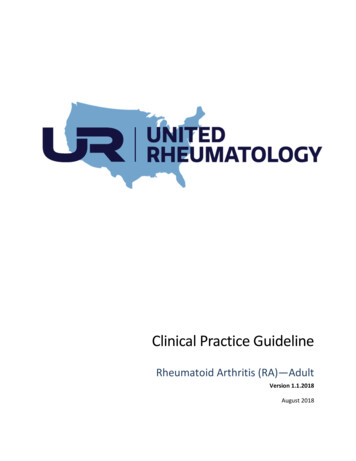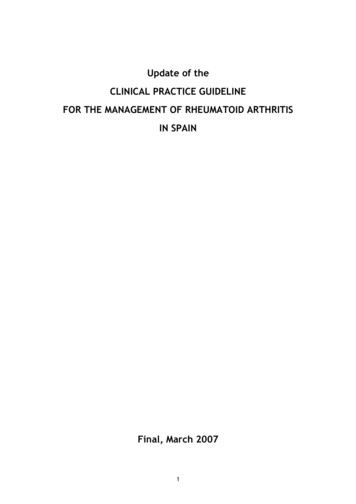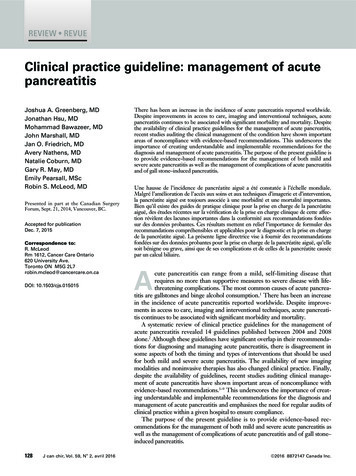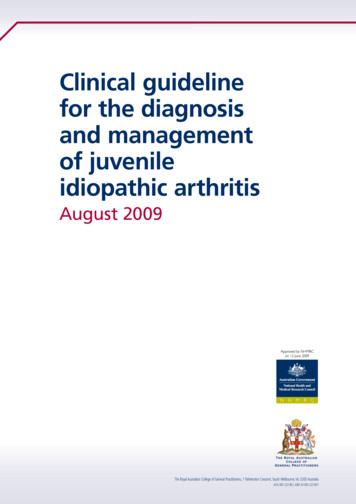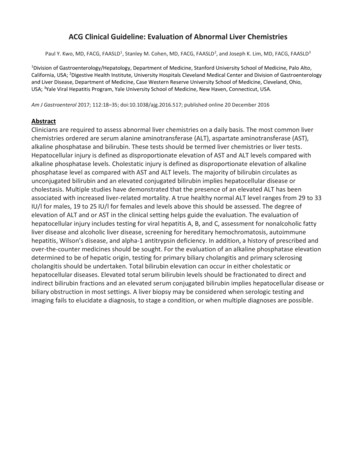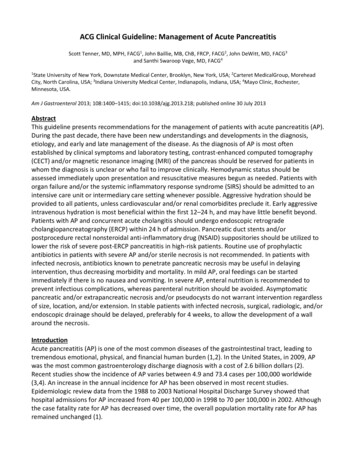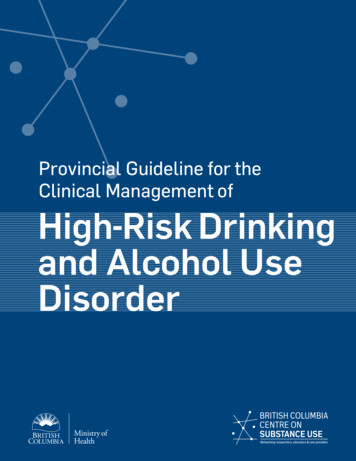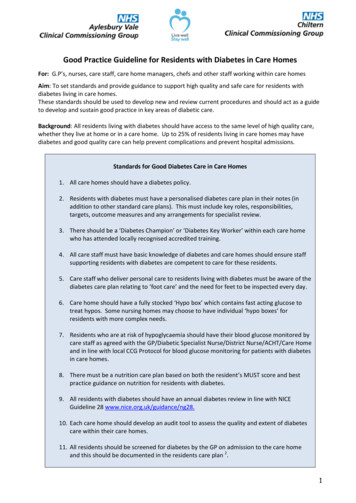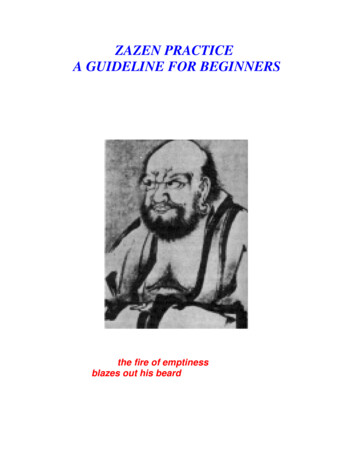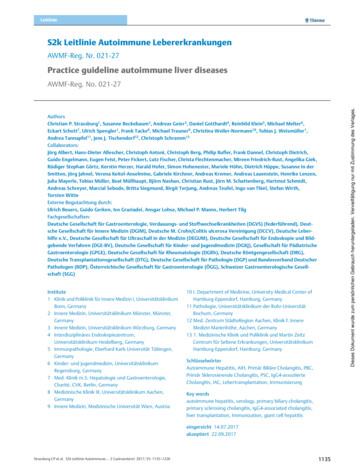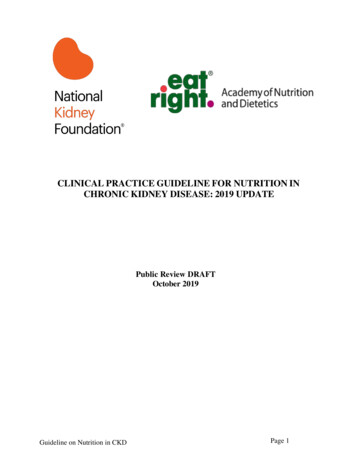
Transcription
CLINICAL PRACTICE GUIDELINE FOR NUTRITION INCHRONIC KIDNEY DISEASE: 2019 UPDATEPublic Review DRAFTOctober 2019Guideline on Nutrition in CKDPage 1
SECTION I: USE OF THE CLINICAL PRACTICE GUIDELINEThis Clinical Practice Guideline document is based upon the best information available as ofApril 2017*. It is designed to provide information and assist decision making. It is not intendedto define a standard of care, and should not be construed as one, nor should it be interpreted asprescribing an exclusive course of management. Variations in practice will inevitably andappropriately occur when clinicians take into account the needs of individual patients, availableresources, and limitations unique to an institution or type of practice. Every health-careprofessional making use of these recommendations is responsible for evaluating theappropriateness of applying them in the setting of any particular clinical situation. Therecommendations for research contained within this document are general and do not imply aspecific protocol.*Commissioned evidence review included articles published through April 2017. Consensusopinion statements use literature published though August 2018.SECTION II: DISCLOSUREKidney Disease Outcomes Quality Initiative (KDOQI) and American Academy of Nutrition andDietetics (AND) make every effort to avoid any actual or reasonably perceived conflicts ofinterest that may arise as a result of an outside relationship or a personal, professional, orbusiness interest of a member of the Work Group. All members of the Work Group are required tocomplete, sign, and submit a disclosure and attestation form showing all such relationships thatmight be perceived or actual conflicts of interest. All reported information will be printedin the final publication and are on file at the National Kidney Foundation (NKF).Guideline on Nutrition in CKDPage 2
TABLE OF CONTENTSTable of Tables . .Table of Figures . Abbreviations and Acronyms Work Group Membership .Organization Leadership . .Abstract .Foreword Methods .Summary of Guideline Statements.Guideline 1: Assessment . . 1.0 Usual Care Statements 1.1Technical Devices & Anthropometric Measurements to Measure Body Composition 1.2 Laboratory Measures of Body Composition .1.3 Handgrip Strength .1.4 Methods to Assess Energy Requirements .1.5 Composite Nutritional Indices to Measure Nutritional Status in CKD Patients .1.6 Tools/Methods Used to Assess Protein Intake and Calorie Intake . .Guideline 2: Medical Nutrition Therapy . Guideline 3: Dietary Protein and Energy Intake . .3.0 Energy Intake .3.1 Protein Amount . .3.2 Protein Type .3.3 Dietary patterns (Fruits and Vegetables; Mediterranean) . .Guideline 4: Nutritional Supplementation . 4.1 Nutrition Supplementation - Oral, Enteral, and Parental Nutrition .4.2Nutrition Supplementation - Dialysate . . 4.3 Long Chain Omega-3 Polyunsaturated Fatty Acids . .Guideline 5: Micronutrients. . .5.0 General Guidance .5.1 Folic acid (with and without other B Vitamins) . .5.2 Vitamin C .5.3 Vitamin D .5.4 Vitamin E and A . .5.5 Vitamin K .5.6 Selenium and Zinc .Guideline 6: Electrolytes. . .6.1 Acid-Base .6.2 Calcium . .6.3 Phosphorus . .6.4 Potassium . .6.5 Sodium . .Biographic and Disclosure Information .References .Guideline on Nutrition in CKDPage 06
TABLESTable 1. Key Questions for Evidence Review . 16Table 2. Evidence Review Inclusion and Exclusion Criteria . 18Table 3. Quality of Evidence Grades 24Table 4. Implications of strong and weak recommendations for different users of guidelines . 25FIGURESFigure 1. Flow diagram of identified studies for Assessment questions . . 21Figure 2. Flow diagram of identified studies for Intervention questions . . 22Guideline on Nutrition in CKDPage 4
ABBREVIATIONS AND ACRONYMSACEAPDANDARBAngiotensin converting enzyme inhibitorsAnimal-based Protein DietAcademy of Nutrition and DieteticsAngiotensin II receptor blockerBFBIABMIBPBPIBody fatBio-electrical impedance analysisBody mass indexBlood pressureBody protein indexCAPDCIMTCKCKDCRPCVDContinuous ambulatory peritoneal dialysisConstraint induced movement therapyCreatinine kinaseChronic kidney diseaseC-reactive proteinCardiovascular diseaseDBPDEXADiastolic blood pressureDual-energy X-ray absorptiometryeGFREAAsESRDEstimated glomerular filtration rateEssential amino acidsEnd-stage renal diseaseFMFFMFSAFat massFat free massFour-site skinfold anthropometryGFRGNRIGRADEGlomerular filtration rateGeriatric Nutrition Risk IndexGrades of Recommendation Assessment, Development, and -density lipoprotein cholesterolHandgrip StrengthHomeostatic Model Assessment of Insulin ResistanceHazard ratioHigh sensitivity C-reactive proteinIBWIDPNIL-6IMTIVIdeal body weightIntradialytic parenteral nutritionInterleukinIntima media thickeningIntravenousGuideline on Nutrition in CKDPage 5
KAKetoacidKAAKetoacid analogueKDIGOKidney Disease: Improving Global OutcomesKDQOL-SF Kidney disease quality of life short formKDOQIKidney Disease Outcomes Quality InitiativeKQKey questionLBMLDL-CLPDLean body massLow-density lipoprotein cholesterolLow protein dietMAMCMF-BIAMGPMHDMHDEMISMNAMNA-SFMSTMUSTMid-arm muscle circumferenceMulti-frequency-bio-electrical impedance analysisMatrix Gla proteinMaintenance hemodialysisMaintenance Hemodialysis EquationMalnutrition Inflammation ScoreMini-nutrition assessmentMini-Nutrition Assessment-Short FormMalnutrition Screening ToolMalnutrition Universal Screening ToolNEAAsNEAPNHANESNISNRCTnPCRnPNANSTNon-essential amino acidsNet endogenous acid productionNational Health and Nutrition Examination SurveyNutrition Impact Symptoms NKFNational Kidney FoundationNon-randomized controlled trialNormalized protein catabolic rateNormalized protein nitrogen appearanceNutrition Screening ToolONSOral nutritional supplementsPCRPDPEWPNAPNIProtein catabolic dietPeritoneal dialysisProtein energy wastingProtein nitrogen appearanceProtein Nutrition IndexRCTsRDNREER-NSTRRTRandomized controlled trialsRegistered dietitian nutritionistResting energy expenditureRenal-Nutrition Screening ToolRenal Replacement TherapyGuideline on Nutrition in CKDPage 6
SBPSGASKFSRSystolic blood pressureSubjective Global AssessmentSkinfold thicknessSystematic reviewTBFTGTNF-aTSFTotal body fatTriglyceridesTumor Necrosis Factor alphaTriceps skinfold thicknessVPDVLPDvs.Vegetable proteindietVery low protein dietVersusGuideline on Nutrition in CKDPage 7
WORK GROUP MEMBERSHIPWork Group Co-ChairsT. Alp Ikizler, MDVanderbilt University Medical CenterNashville, TN, USALilian Cuppari, PhDOswaldo Ramos Foundation-HrimFederal University of Sao PauloSão Paulo, BrazilWork GroupJerrilynn Burrowes, PhD, RD, CDNLong Island University Brookville,NY, USALaura Byham-Gray, PhD, RD, CDNRutgers UniversityNewark, NJ, USAKatrina Campbell, PhDBond UniversityRobina, Queensland, AustraliaJuan Jesus Carrero, Pharm, PhD Pharm, PhD MedKarolinska InstitutetStockholm, SwedenWinnie Chan, PhD, RDQueen Elizabeth Hospital BirminghamBirmingham, United KingdomDenis Fouque, MD, PhDUniversity Claude Bernard LyonLyon, FranceAllon Friedman, MD, FASNIndiana University Carmel,Indianapolis, IN, USASana Ghaddar, PhD, RDNDaVitaSan Francisco, CA, USAJordi Goldstein-Fuchs, DSc, APRN-C, RDSierra Nevada Nephrology ConsultantsReno, NV, USAGeorge Kaysen, MD, PhDUniversity of California-Davis,Davis, CA, USAJoel Kopple, MDLundquist Institute for Biomedical Innovation atHarbor-UCLA Medical Center and UCLATorrance, CA, USADaniel Teta, MD, PhDLausanne UniversityLausanne, SwitzerlandAngela Yee-Moon Wang, MD, PhDUniversity of Hong KongHong KongEvidence Review TeamDeepa Handu, PhD, RD, LDNAcademy of Nutrition and DieteticsChicago, IL, USAGuideline on Nutrition in CKDMary Rozga, PhD, RDNAcademy of Nutrition and DieteticsChicago, IL, USAPage 8
KDOQI and Academy Guideline Development StaffKerry Willis, PhDNational Kidney FoundationNew York, NYJessica Joseph, MBANational Kidney FoundationNew York, NYLaura Brereton, MScNational Kidney FoundationNew York, NYTom Manley, RN, BSNNational Kidney FoundationNew York, NYAlison Steiber, PhD, RDNAcademy of Nutrition and DieteticsChicago, IL, USAMary Rozga, PhD, RDNAcademy of Nutrition and DieteticsChicago, IL, USADeepa Handu, PhD, RDN, LDNAcademy of Nutrition and DieteticsChicago, IL, USAOrganizational LeadershipAcademy of Nutrition and DieteticsKDOQIAlison Steiber, PhD, RDNChief Science OfficerMichael Rocco, MD, MSCEKDOQI ChairHolly Kramer, MDVice Chair, ResearchPresident, National Kidney FoundationBernard Jaar, MD MPHVice Chair, EducationMichael J. Choi, MDVice Chair, PolicyPast President, National Kidney FoundationGuideline on Nutrition in CKDPage 9
METHODSThe Guideline Development ProcessAccording to the Institute of Medicine (National Academy of Sciences), “Clinical practiceguidelines are statements that include recommendations intended to optimize patient care thatare informed by a systematic review of evidence and an assessment of the benefits and harmsof alternative care options”. This chapter describes the process and methods used to conductcomprehensives systematic reviews and how the findings from these systematic reviews wereused to develop clinical practice nutrition guidelines for patients with chronic kidney disease.These guidelines were developed according to the Standards for Developing TrustworthyClinical Practice Guidelines as stated by Institute of Medicine.Development of these guidelines was a collaborative process between National KidneyFoundation (NKF) and the Academy of Nutrition and Dietetics (Academy). Nutrition and itsmanagement are an integral aspect of care for patients with kidney disease. Due to recentdevelopments in the literature regarding treatment and assessment of CKD, the Academy andNKF collaborated to merge, update and expand the current 2010 Evidence Analysis Library (EAL ) CKD guidelines and the Kidney Disease Outcomes Quality Initiative (KDOQI)Nutrition Guidelines. Hence, the objective of this initiative is to provide medical nutritiontherapy (MNT) guidelines for patients with chronic kidney disease (CKD) to assess, preventand treat protein-energy wasting, mineral and electrolyte disorders, and other metabolic comorbidities associated with CKD.Overview of the guideline development process: Guideline development is a detailed andcomprehensive process. The steps followed to develop this guideline are below (some stepswere completed concurrently):1. Select the Work group or expert panel that works with the evidence review team.2. Orient the work group the 5-step systematic review process of the Academy ofNutrition and Dietetics’ Evidence Analysis Center.3. Develop research questions, inclusion and exclusion criteria and a detailed search planas well as identify interventions and outcomes of interest.Guideline on Nutrition in CKDPage 10
4. Search multiple databases based on search plan.5. Screen abstracts and full text articles based on a priori eligibility criteria.6. Extract data and critically assess the quality of included studies (risk of bias of studies)7. Synthesize evidence narratively (evidence summary and conclusion statements) and intable format (Study characteristics and findings table). Grade the quality of evidence foreach outcome and provide GRADE tables.8. Develop recommendation statements based on the findings of the systematic reviewand other important considerations and assign “strength of recommendation”.9. Write a guideline manuscript.10. Conduct internal, external, and public review of the guideline.11. Respond to reviewer comments and update the guideline before publication.Work group selection process: The Academy of Nutrition and Dietetics led the process of workgroup member recruitment. To assure appropriate expertise and limit bias, the Evidence BasedPractice Committee Work Group Selection sub-committee followed a transparent process ofselecting work group members. An open recruitment message with a link to online applicationwas circulated via stakeholders for experts in the topic area of chronic kidney disease.Interested candidates provided: signed Disclosure and Conflict of Interest From, curriculumvitae, and personal statements indicating interest and qualifications that related to the topic.The workgroup selection committee then evaluated each candidate based on set criteria.Higher scoring candidates were considered for position of workgroup chair /co-chair. A totalof 15 workgroup members were selected to develop these guidelines. Two co-chairs wereappointed, and the work group consisted of physicians, registered dietitians or nutritionists,researchers, and methodologists with expertise in the renal nutrition field. The selectedmembers, according to their experiences and skill sets, were assigned to correspondingsubtopics. The work group participated in all steps of systematic review process, whichincluded developing research questions, agreeing on inclusion and exclusive criteria,developing the search plan, evaluating the evidence, and approving and grading the evidenceand developing recommendation statements. All workgroup members and the evidence reviewteam (ERT) met twice for 2-day face to face meetings as well as a teleconference calls once amonth for the duration of the project.Guideline on Nutrition in CKDPage 11
Guideline focus: During the first meeting the work group defined the scope for the guideline.The co-chairs developed the first draft of the scope which was discussed and refined by thework group members. It was determined that the guideline would focus on Nutrition in allstages of CKD in adults and would cover the subtopics of macronutrient, micronutrient, andelectrolyte management in CKD. Both assessment and intervention question under thesesubtopics were proposed. Three workgroups were developed, with five members assigned toeach workgroup and a Chair appointed to help lead the workgroup.Systematic review process: Question development, literature search and study selection Thisguideline followed the Academy of Nutrition and Dietetics systematic review methodology.An analytical framework was developed by the ERT and refined by the work groupmembers to help guide question development. During the initial teleconference calls andfirst face to face meeting, the workgroup developed a list of questions that were deemedimportant for clinicians and patients (Table 1). The workgroup developed the a priori inclusionand exclusion criteria as listed in Table 2.A comprehensive search of literature was conducted using PubMed, MEDLINE, EMBASE,and CINAHL search engines. A first literature search was conducted to identify studiesaddressing assessment questions and a second search was conducted to identify studiesaddressing intervention questions in order to identify studies that answered more than onequestion. Inclusion criteria included in the search plan included: human adults with CKD aged19 years and older published between 1985 and December 2016. hu Search terms includedterms to identify relevant nutrition interventions assessment tools in adult CKD patients.The first literature search focused on assessment questions identified 4,857 potential studies.The PRISMA diagram illustrating the study selection process are presented in Figure 1. Thesecond comprehensive search to answer all the intervention questions in order identified11,017 potential studies. The PRISMA diagram illustrating study selection process forintervention questions is in Figure 2.Guideline on Nutrition in CKDPage 12
After the search was completed, studies were systematically screened based additional a prioriinclusion/exclusion criteria. For intervention questions, only randomized controlled trials thathad at least 6 individuals per arm were included. Included studies investigated an interventionof interest (e.g. protein restrictions, phosphorus intake, sodium intake etc.) in comparison withno intervention or minimal intervention. For assessment questions, only studies that tested thevalidity, reliability or relationship of an assessment tool against a comparative tool (referencestandard) or mortality were included in this review.The list of titles and abstracts were independently reviewed and marked for inclusion orexclusion (along with the reason) and any differences were resolved by discussion with a thirdreviewer. Full texts of articles meeting inclusion criteria were ordered and reviewed forinclusion. 225 studies met the inclusion criteria for Intervention questions and 125 forassessment articles. A list of excluded articles with reason for exclusion was also created tomaintain transparency (available of Academy of Nutrition and Dietetics Evidence AnalysisCenter website).Data extraction and study quality assessment: Relevant data was extracted from the includedarticles using a standardized online data extraction tool. Key information extracted from eachstudy included: Authors information; year of publication; type of study design; details ofintervention: type of intervention, duration of the intervention, who delivered the intervention,setting, number of centers; Participants: sample size, mean age, age range, gender, studyinclusion and exclusion criteria, comorbidities; Interventions: intervention details, comparisongroup details, medication use; Outcomes: reported primary and secondary outcomes, timepoints of reported outcomes; other details such as funding source.All included studies were critically appraised for risk of bias. Two independent reviewersassessed the quality or studies using the Academy’s online risk of bias tool, the Quality CriteriaChecklist (QCC). The questions of the QCC are based on quality constructs and risk of biasdomains identified by the Cochrane Collaboration and the Agency for Healthcare Research adQuality (AHRQ). Questions examine sampling bias, performance bias, detection bias, attritionGuideline on Nutrition in CKDPage 13
bias, and reporting bias. Any discrepancies between the two reviewers were resolved byconsensus or by a third reviewer.Data synthesis and grading the evidence: Descriptive synthesis of evidence was conducted forall identified outcomes for which there were included studies. When possible, meta-analysiswas conducted using random-effects model. For continuous data, results were summarized asmean difference (MD) between treatment groups (intervention v/s control/placebo) with 95%confidence interval (CI) or standardized mean differences (SMD). Dichotomous outcomeswere reported as odds ratio (OR) or risk ratios (RR) with 95% CI. The I2 statistic was used todetermine the degree of heterogeneity in the calculated effect size, and 25%, 50%, and 75%were considered low, moderate, high, respectively. Sub-group analysis was conducted asappropriate to manage clinical heterogeneity.After completion of the data extraction and data synthesis, the ERT provided the systematicreview results in the following formats for the workgroup to review, edit, and approve: 1)Evidence summary: a narrative summary of all included trials for each identified outcome wasdrafted for each research question in the systematic review. A conclusion statement wasdeveloped for each proposed question /outcome. The conclusion statement is a clear, simpleand to the point answer to the proposed questions.; 2) Study characteristics table: providedinformation regarding study characteristics, sample size, population, intervention details andquality of each included study; 3) Quality of evidence (strength of evidence): Each of theconclusion statements were assigned a GRADE (reference) to reflect the quality of studies,inconsistency of results, imprecision, indirectness of the evidence, and publication bias. Usingthis method, the evidence for each outcome of interest was graded as A (high), B (moderate), C(low), or D (very low). A GRADE table was generated using GradePro and demonstrated howthe strength of evidence (GRADE) was derived for each outcome of interest.Guideline development: The workgroup members drafted comprehensive recommendations fornutrition care for adults with CKD. During this phase, the role of the work group member wasto translate the available evidence into action statements that were clear, concise, and ready toGuideline on Nutrition in CKDPage 14
be implemented by practitioners. The workgroup and ERT used the GRADE method fordevelopment of recommendations. The GRADE method involves two major components: arating for quality of evidence (described above) and rating the strength of recommendations.The evidence grades are reported at the end of the recommendation statements (e.g. A, B, C, orD) and reflect the confidence in the estimated effects (Table 3).The second component is rating the strength of the recommendation statement. This ratingreflects the extent to which one is confident that desirable effects of an intervention outweighundesirable effects. The grade for strength of the recommendation can be assigned Level 1 orLevel 2. Table 4 shows the implication of each level for practitioners, clinicians, and policymakers. Level 1 recommendations use the terminology “We recommend”, which means thatthis course of action should be applied to most people and practitioners can have confidencethat implementing this recommendation has more benefit than risk. Level 2 recommendationsuse the terminology “We suggest”.When providing the level for the strength of the recommendation, a number of factors besidesthe quality of evidence are taken into consideration, including patient values and preferences,quality of evidence, benefits and harms, cost/resources to implement the recommendation,acceptability, feasibility, and health equity. In addition to evidence-based recommendations, incertain scenarios “Opinion” statements were developed. These statements were developedwhen there was not enough evidence or evidence had too low of quality to write a gradedrecommendation, but the workgroup determined it was important to provide some guidance topatients and practitioners. These recommendations are ungraded, and usually refer to generalor routine practice.Once the full draft of recommendation statements was ready, it was reviewed and editedmultiple times by all the workgroup members and the ERT. The workgroup participated in afinal blinded vote of recommendation statements, and a majority of votes approving thestatement was necessary for each statement to be accepted into the final guideline.Guideline on Nutrition in CKDPage 15
Draft report with supporting rationale: Once the recommendation statements were developed,the work group members drafted a guideline manuscript that included the supporting materialsfor each topic, including rationale, detailed justification (evidence summary), specialdiscussions, implementation considerations, risks and harms, costs, and need for futureresearch. In these sections the work group members also cited additional references importantto the respective topic, including discussion of studies published after our search dates or othersystematic reviews on the topic.Peer review process: These guidelines underwent a systematic peer review process. The firstphase of review was an internal review conducted by KDOQI leadership and the NationalKidney Foundation Scientific Advisory Board. Feedback from this internal review werereviewed and incorporated in the guideline as appropriate. The second phase of the review wasan external review conducted by 12 experts in this field. The AGREE II tool (Appraisal ofGuidelines for Research and Evaluation) criteria was used to assess the quality of guidelinereporting. The third phase was an open, public review phase. Reviewer comments from allphases were collated by staff and sent to workgroup members for discussion and possible edits.Work group chairs coordinated the final revision of the guideline document based on reviewcomments and the final guideline manuscript will be submitted for publication.Table 1. Key Questions for Evidence ReviewTopicsAssessment:Nutritional statusAssessment:MacronutrientsQuestionsWhat composite nutritional indices should be used to assess nutritionalstatus, and/or protein-energy wasting in adults with CKD 1-5D, nondialysis and transplant?What technical devices and anthropometric measures should be used toassess body composition in adults with CKD 1-5D, non-dialyzed andtransplant?What laboratory measures should be used to assess nutritional status inadults with CKD 1-5D, non-dialysis and transplant?Is there evidence to support the use of hand-grip strength for assessingnutritional status in adults with CKD 1-5D, non-dialyzed and transplant?What methods should be used to assess dietary intake of energy andprotein in adults with CKD 1-5D, non-dialysis and transplant?What methods should be used assess energy and protein requirements inadults with CKD 1-5D, non-dialysis and transplant?Guideline on Nutrition in CKDPage 16
dical NutritionTherapyMacronutrient:Protein restrictionand typeMacronutrient:Dietary utrient: plementsMacronutrient:IDPN ctrolytes:interventionquestionsWhat methods should be used to assess micronutrient intake in adultswith CKD 1-5D, non-dialysis and transplant?What methods should be used to assess micronutrient needs in adultswith CKD 1-5, non-dialysis and transplant?What methods should be to assess micronutrient status in adults withCKD 1-5, non-dialysis and transplant?What are the methods should be used to assess dietary electrolyte intakein adults with CKD 1-5D, non-dialysis and transplant?What methods should be used to assess electrolyte needs in adults withCKD 1-5, non-dialysis and transplant?3. What methods should be used to assess electrolyte status in adultswith CKD 1-5, non-dialysis and transplant?What is the effect of MNT provided by a registered dietitian orinternational equivalent on outcomes in adult patients with CKD 1-5D,non-dialysis and transplant?What is the effect of protein restriction, with or without ketoanalogues ofamino acids, intake on outcomes in adults with CKD 1-5D, non-dialysisand transplant?What is the effect of protein type (animal vs plant) intake on outcomes inadults with CKD 1-5D, non-dialysis and transplant?What is the effect of specific dietary patterns on outcomes in patientswith CKD 1-5, non-dialysis and transplant?What is the effect of omega 3 supplementation on outcomes in adultswith CKD 1-5D, non-dialysis and transplant?What is the effect of oral nutritional supplementation on outcomes inadults with CKD 1-5, non-dialysis and transplant?What is the effect of nutritional supplementation via dialysate onoutcomes in adults with CKD 1-5D, non-dialysis and transplant?What is the effect of nutritional supplementation via IDPN on outcomesin adults with CKD 1-5D, non-dialysis and transplant?What is the effect of micronutrient intake (B vitamins, vitamins C, D, Eand K and selenium and zinc) on outcomes in adults with CKD 1-5D,non-dialysis and transplant?What is the effect of dietary intake of (acid-base, calcium, phosphorus,potassium, magnesium, sodium) on (electrolyte) biomarkers and otherhealth outcomes in adults with CKD 1-5D, non-dialysis and transplant?Guideline on Nutrition in CKDPage 17
Table 2. Evidence Review Inclusion and Exclusion CriteriaAssessment Research QuestionsInclusionAgeAdults (age 18 and older)SettingHealth StatusNutrition RelatedProblem/ConditionStudy DesignPreferencesOutcomesClinical or outpatientCKD of any stage, nephroticsyndrome, maintenancehemodialysis chronic peritonealdialysis, and kidneytransplantation with differentCKD stages, with or withoutdyslipidemia and diabetes;kidney transplant recipientsChronic kidney disease Diagnostic, validity,reliability studies,prediction, and/orcorrelation studies Studies need to have acomparative tool/methodincludedEvaluates validity,agreement and reliability ofthe screening toolReports one or more of thefollowing outcomes: Validity [e.g., construct(convergent, divergent)criterion (concurrent orpredictive)] Reliability (e.g., inter- orintra-rater) Sensitivity / Specificity Positive and/or negativepredictive valueGuideline on Nutrition in CKDE
PCR Protein catabolic diet PD Peritoneal dialysis PEW Protein energy wasting PNA Protein nitrogen appearance PNI Protein Nutrition Index RCTs Randomized controlled trials RDN Registered dietitian nutritionist REE Resting energy expenditure R-NST Renal-Nutrition Scre
